Any advice is welcomed thank you!
Our measures for what is possible in regards to growth vary.
I'd argue with as much as newbs cut trees, it fights greatly against a good understanding of what robust growth is actually possible.
My personal measure of elm growth comes from a seedling that self started in a half pond basket. I just left it grow and it was about 3/4in. thick and about 4ft tall by the end of the first season. The first time I witnessed triple ramification naturally.
It's by that measure that I see things like this as, not exactly "foolish" though they could be called such, but just mathematically wrong.
I think we lose our mathematical correctness in our excitement of a new hobby, the giddyness of a particular vision for something in front of us.
The math is wrong because if you have a good realistic measure of robust growth, you begin to realize that you can take a cutting of that plant and be at a beginning better than the one you have in only one year. Which I'd argue could save you 3 years. Of course this is some type of idea of time and subjective aesthetics jumbled into one "truth" that doesn't matter except to explain.
The real understanding is that 1 or 3 years doesn't really matter, as it's but a drop in the bucket of the 20 years or so the whole endeavor should take.
So rather than be so focused on what this one thing can be, know that your 8th to 15th cuttings may be the ones that really develop without difficulty, so well that you may voluntarily burn this one in the future.
The biggest trap is wanting to "do". We "do" all wrong and don't work with the trees.
I think it's more rewarding at every measure, to grow 6 trees without forcing them into an idea, and be returned 3 of excellence that we accept.
Than to waste time trying to fit one thing into this preconceived box of "acceptance".
Snip. Snip.
Sorce






